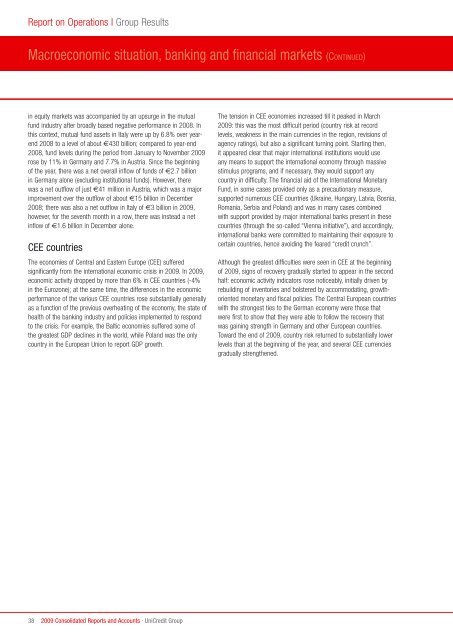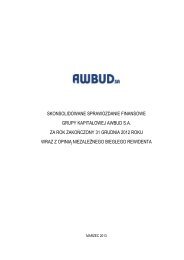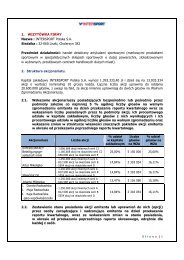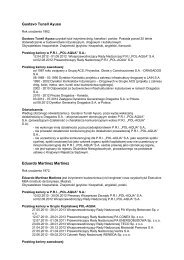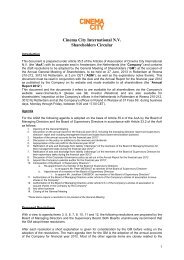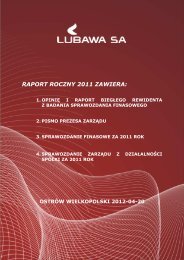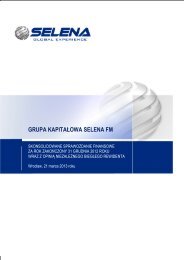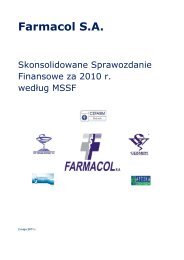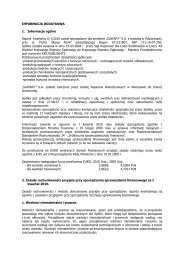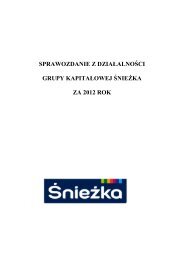- Page 1 and 2: 2009 Consolidated Reports and Accou
- Page 3 and 4: Times change, but commitments do no
- Page 5 and 6: Contents Introduction 5 Board of Di
- Page 7 and 8: Introduction Board of Directors and
- Page 9 and 10: Board of Directors and Board of Sta
- Page 11 and 12: egion. Both countries, as others in
- Page 13 and 14: REVENUES BY REGION 4 (%) 24.4 7.7 1
- Page 15 and 16: CENTRAL AND EASTERN EUROPE UniCredi
- Page 17 and 18: Today’s UniCredit Group is a youn
- Page 19 and 20: Strategy and Results CEO’s Letter
- Page 21 and 22: to be one of the most important ban
- Page 23 and 24: Note to the Report on Operations an
- Page 25 and 26: Consolidation Area In 2009 there we
- Page 27 and 28: Report on Operations Notes The foll
- Page 29 and 30: Profitability Ratios 2009 2008 CHAN
- Page 31 and 32: Income Statement Consolidated Incom
- Page 33 and 34: Income Statement Consolidated Incom
- Page 35 and 36: Segment Reporting (Summary) Key fig
- Page 37 and 38: UniCredit Share Share information 2
- Page 39: “Quantitative Easing” policy by
- Page 43 and 44: Operating profit by business segmen
- Page 45 and 46: Operating Costs 2009 operating cost
- Page 47 and 48: Net Impairment Losses on Loans and
- Page 49 and 50: Capital and Value Management Princi
- Page 51 and 52: Results by Business Segment The 200
- Page 53 and 54: Financial performance The figures f
- Page 55 and 56: ond issue of UniCredit Family Finan
- Page 57 and 58: Retail Network Germany UniCredit Ba
- Page 59 and 60: anches with disbursements amounting
- Page 61 and 62: Corporate & Investment Banking (CIB
- Page 63 and 64: fee contribution was weak since it
- Page 65 and 66: from analyzing cash and payment flo
- Page 67 and 68: The new organizational model is bei
- Page 69 and 70: Net of extraordinary items 1 , the
- Page 71 and 72: Private Banking Italy reported arou
- Page 73 and 74: Asset Management Introduction AT A
- Page 75 and 76: Breakdown by business, geographic a
- Page 77 and 78: CEE and Poland’s Markets / Centra
- Page 79 and 80: The market-driven relative slowdown
- Page 81 and 82: Despite a challenging year in 2009,
- Page 83 and 84: eached RON 335mn (€78mn), less th
- Page 85 and 86: Poland’s Markets Introduction AT
- Page 87 and 88: global financial crisis, Corporate
- Page 89 and 90: The direct costs of SBA show a redu
- Page 91 and 92:
Workout Services This department pr
- Page 93 and 94:
With regard to developments in the
- Page 95 and 96:
Global ICT Company The project was
- Page 97 and 98:
Reorganization of the Austrian Priv
- Page 99 and 100:
Outside Italy BodeHewitt AG & Co. K
- Page 101 and 102:
Capital Strengthening In the early
- Page 103 and 104:
Subsequent Events and Outlook Subse
- Page 106 and 107:
Christian Hagn, Hagn & Dr. Ruebesam
- Page 108 and 109:
Corporate Governance Governance org
- Page 110 and 111:
Corporate Governance Governance org
- Page 112 and 113:
Corporate Governance Governance org
- Page 114 and 115:
Corporate Governance Governance org
- Page 116 and 117:
Corporate Governance Management Com
- Page 118 and 119:
Corporate Governance Group Manageme
- Page 121 and 122:
Consolidated Financial Statements C
- Page 123 and 124:
Consolidated Accounts RELASEMESTRAL
- Page 125 and 126:
Consolidated Balance Sheet RELASEME
- Page 127 and 128:
RELASEMESTRALE CONSOLIDATA 125 >> C
- Page 129 and 130:
Consolidated Financial Statements C
- Page 131 and 132:
RELASEMESTRALE CONSOLIDATA 129 >> C
- Page 133 and 134:
131 >> Consolidated Financial State
- Page 135 and 136:
133 Part A - Accounting Policies >>
- Page 137 and 138:
135 >> Financial Statements Part A
- Page 139 and 140:
Section 3 - Consolidation Procedure
- Page 141 and 142:
139 >> Financial Statements Part A
- Page 143 and 144:
141 >> Financial Statements Part A
- Page 145 and 146:
143 >> Financial Statements Part A
- Page 147 and 148:
145 >> Financial Statements Part A
- Page 149 and 150:
NAME MAIN OFFICE 147 >> Financial S
- Page 151 and 152:
149 >> Financial Statements Part A
- Page 153 and 154:
NAME MAIN OFFICE 151 >> Financial S
- Page 155 and 156:
153 >> Financial Statements Part A
- Page 157 and 158:
NAME MAIN OFFICE 155 >> Financial S
- Page 159 and 160:
NAME MAIN OFFICE 157 >> Financial S
- Page 161 and 162:
159 >> Financial Statements Part A
- Page 163 and 164:
161 >> Financial Statements Part A
- Page 165 and 166:
Changes in the scope of consolidati
- Page 167 and 168:
Reductions Disposals 165 >> Financi
- Page 169 and 170:
Section 4 - Subsequent Events 167 >
- Page 171 and 172:
As at 31 December 2009 the IASB had
- Page 173 and 174:
171 >> Financial Statements Part A
- Page 175 and 176:
173 >> Financial Statements Part A
- Page 177 and 178:
175 >> Financial Statements Part A
- Page 179 and 180:
6 - Hedge Accounting Derivative hed
- Page 181 and 182:
7 - Equity Investments 179 >> Finan
- Page 183 and 184:
9 - Intangible Assets 181 >> Financ
- Page 185 and 186:
183 >> Financial Statements Part A
- Page 187 and 188:
13 - Liabilities, Securities in Iss
- Page 189 and 190:
187 >> Financial Statements Part A
- Page 191 and 192:
189 >> Financial Statements Part A
- Page 193 and 194:
191 >> Financial Statements Part A
- Page 195 and 196:
Relevant IFRS definitions 193 >> Fi
- Page 197 and 198:
195 >> Financial Statements Part A
- Page 199 and 200:
197 >> Financial Statements Part A
- Page 201 and 202:
199 >> Financial Statements Part A
- Page 203 and 204:
201 >> Financial Statements Part A
- Page 205 and 206:
203 >> Consolidated Financial State
- Page 207 and 208:
205 >> Consolidated Financial State
- Page 209 and 210:
Financial Assets Held for Trading 2
- Page 211 and 212:
209 >> Consolidated Financial State
- Page 213 and 214:
211 >> Consolidated Financial State
- Page 215 and 216:
Section 6 - Loans and receivables w
- Page 217 and 218:
215 >> Consolidated Financial State
- Page 219 and 220:
217 >> Consolidated Financial State
- Page 221 and 222:
219 >> Consolidated Financial State
- Page 223 and 224:
221 >> Consolidated Financial State
- Page 225 and 226:
223 >> Consolidated Financial State
- Page 227 and 228:
Section 12 - Property, plant and eq
- Page 229 and 230:
227 >> Consolidated Financial State
- Page 231 and 232:
13.3 Other information Information
- Page 233 and 234:
231 >> Consolidated Financial State
- Page 235 and 236:
233 >> Consolidated Financial State
- Page 237 and 238:
235 >> Consolidated Financial State
- Page 239 and 240:
237 >> Consolidated Financial State
- Page 241 and 242:
239 >> Consolidated Financial State
- Page 243 and 244:
241 >> Consolidated Financial State
- Page 245 and 246:
243 >> Consolidated Financial State
- Page 247 and 248:
15.2 Other informazion There is no
- Page 249 and 250:
247 >> Consolidated Financial State
- Page 251 and 252:
Section 3 - Debt securities in issu
- Page 253 and 254:
251 >> Consolidated Financial State
- Page 255 and 256:
Section 8 - Tax liabilities - Item
- Page 257 and 258:
255 >> Consolidated Financial State
- Page 259 and 260:
Section 13 - Insurance reserves - I
- Page 261 and 262:
259 >> Consolidated Financial State
- Page 263 and 264:
Section 16 - Minorities - Item 210
- Page 265 and 266:
4. Breakdown of investments relatin
- Page 267 and 268:
Part C) Consolidated Income Stateme
- Page 269 and 270:
267 >> Consolidated Financial State
- Page 271 and 272:
269 >> Consolidated Financial State
- Page 273 and 274:
271 >> Consolidated Financial State
- Page 275 and 276:
273 >> Consolidated Financial State
- Page 277 and 278:
275 >> Consolidated Financial State
- Page 279 and 280:
277 >> Consolidated Financial State
- Page 281 and 282:
279 >> Consolidated Financial State
- Page 283 and 284:
Section 12 - Provisions - Item 190
- Page 285 and 286:
Section 16 - Profit (loss) of assoc
- Page 287 and 288:
285 >> Consolidated Financial State
- Page 289 and 290:
287 >> Consolidated Financial State
- Page 291 and 292:
289 >> Consolidated Financial State
- Page 293 and 294:
291 >> Consolidated Financial State
- Page 295 and 296:
293 >> Consolidated Financial State
- Page 297 and 298:
295 >> Consolidated Financial State
- Page 299 and 300:
values proving inconsistent with cu
- Page 301 and 302:
Section 1 - Credit Risk Qualitative
- Page 303 and 304:
301 >> Consolidated Financial State
- Page 305 and 306:
303 >> Consolidated Financial State
- Page 307 and 308:
305 >> Consolidated Financial State
- Page 309 and 310:
307 >> Consolidated Financial State
- Page 311 and 312:
309 >> Consolidated Financial State
- Page 313 and 314:
311 >> Consolidated Financial State
- Page 315 and 316:
A.1.6 Banking group - On- and off-b
- Page 317 and 318:
315 >> Consolidated Financial State
- Page 319 and 320:
317 >> Consolidated Financial State
- Page 321 and 322:
319 >> Consolidated Financial State
- Page 323 and 324:
C. Securitisation and sale transact
- Page 325 and 326:
ORIGINATOR: UniCredit S.p.A. (ex Ca
- Page 327 and 328:
ORIGINATOR: UniCredit S.p.A. (ex Ca
- Page 329 and 330:
327 >> Consolidated Financial State
- Page 331 and 332:
329 >> Consolidated Financial State
- Page 333 and 334:
331 ORIGINATOR: UniCredit Leasing S
- Page 335 and 336:
333 Transactions previous periods N
- Page 337 and 338:
ORIGINATOR: Fineco Leasing S.p.A. T
- Page 339 and 340:
ORIGINATOR: UNICREDIT BANK AG (ex H
- Page 341 and 342:
339 ORIGINATOR: UNICREDIT BANK AG (
- Page 343 and 344:
341 ORIGINATOR: UNICREDIT BANK AG (
- Page 345 and 346:
343 >> Consolidated Financial State
- Page 347 and 348:
345 >> Consolidated Financial State
- Page 349 and 350:
Quantitative Information 347 >> Con
- Page 351 and 352:
349 >> Consolidated Financial State
- Page 353 and 354:
351 >> Consolidated Financial State
- Page 355 and 356:
353 >> Consolidated Financial State
- Page 357 and 358:
C.1.7 Banking Group - Servicer acti
- Page 359 and 360:
357 >> Consolidated Financial State
- Page 361 and 362:
359 >> Consolidated Financial State
- Page 363 and 364:
361 >> Consolidated Financial State
- Page 365 and 366:
363 >> Consolidated Financial State
- Page 367 and 368:
365 >> Consolidated Financial State
- Page 369 and 370:
C.2 Sales Transactions C.2.1 Bankin
- Page 371 and 372:
369 >> Consolidated Financial State
- Page 373 and 374:
371 >> Consolidated Financial State
- Page 375 and 376:
Securitized assets broken down by a
- Page 377 and 378:
375 >> Consolidated Financial State
- Page 379 and 380:
1.3 Other non-consolidated SPVs 377
- Page 381 and 382:
Loans and guarantees 379 >> Consoli
- Page 383 and 384:
381 >> Consolidated Financial State
- Page 385 and 386:
1.4 Reclassification of Structured
- Page 387 and 388:
The following table gives the amoun
- Page 389 and 390:
387 >> Consolidated Financial State
- Page 391 and 392:
389 >> Consolidated Financial State
- Page 393 and 394:
391 >> Consolidated Financial State
- Page 395 and 396:
BA AG 393 60,000,000 50,000,000 40,
- Page 397 and 398:
Quantitative information 395 >> Con
- Page 399 and 400:
397 >> Consolidated Financial State
- Page 401 and 402:
399 >> Consolidated Financial State
- Page 403 and 404:
2.6 Derivative instruments A. Finan
- Page 405 and 406:
403 >> Consolidated Financial State
- Page 407 and 408:
A.9 OTC financial derivatives - res
- Page 409 and 410:
407 >> Consolidated Financial State
- Page 411 and 412:
Credit Spread Sensitivity 409 >> Co
- Page 413 and 414:
411 >> Consolidated Financial State
- Page 415 and 416:
€ million Scenario Total US Reces
- Page 417 and 418:
415 >> Consolidated Financial State
- Page 419 and 420:
The standard measures taken for suc
- Page 421 and 422:
419 >> Consolidated Financial State
- Page 423 and 424:
421 >> Consolidated Financial State
- Page 425 and 426:
Section 4 - Operational Risk Qualit
- Page 427 and 428:
425 >> Consolidated Financial State
- Page 429 and 430:
Special Representative 427 >> Conso
- Page 431 and 432:
International Industrial Participat
- Page 433 and 434:
431 >> Consolidated Financial State
- Page 435 and 436:
Valauret S.A. 433 >> Consolidated F
- Page 437 and 438:
435 >> Consolidated Financial State
- Page 439 and 440:
437 >> Consolidated Financial State
- Page 441 and 442:
439 >> Consolidated Financial State
- Page 443 and 444:
RELEVANT EVENTS OCCURRING AFTER 12/
- Page 445 and 446:
Quantitative Information 443 >> Con
- Page 447 and 448:
Internal Capital Adequacy Assessmen
- Page 449 and 450:
Reputational Risk 447 >> Consolidat
- Page 451 and 452:
449 >> Consolidated Financial State
- Page 453 and 454:
451 >> Consolidated Financial State
- Page 455 and 456:
453 >> Consolidated Financial State
- Page 457 and 458:
B. Quantitative information Regulat
- Page 459 and 460:
457 >> Consolidated Financial State
- Page 461 and 462:
459 Part G - Business Combinations
- Page 463 and 464:
461 >> Consolidated Financial State
- Page 465 and 466:
463 >> Consolidated Financial State
- Page 467 and 468:
2. Related-Party Transactions 465 >
- Page 469 and 470:
467 >> Consolidated Financial State
- Page 471 and 472:
469 Part I - Share-Based Payments >
- Page 473 and 474:
1.2 Measurement model 1.2.1 Stock O
- Page 475 and 476:
Other UniCredit equity instruments:
- Page 477 and 478:
Financial statement presentation re
- Page 479 and 480:
477 Part L - Segment Reporting >> C
- Page 481 and 482:
Asset Management 479 >> Consolidate
- Page 483 and 484:
Segment Reporting by Business Segme
- Page 485 and 486:
483 >> Consolidated Financial State
- Page 487 and 488:
485 Annexes Annex 1 Reconciliation
- Page 489 and 490:
Consolidated Balance Sheet (Continu
- Page 491 and 492:
Consolidated Income Statement (Cont
- Page 493 and 494:
Annex 3 - Statement of significant
- Page 495 and 496:
Annex 3 BA-CA ANDANTE LEASING GMBH
- Page 497 and 498:
BC EUROPEAN CAPITAL VII-12 L.P. LON
- Page 499 and 500:
Annex 3 CA-LEASING TERRA POSLOVANJE
- Page 501 and 502:
Annex 3 DAB BANK AG MUNICH GERMANY
- Page 503 and 504:
Annex 3 FONTANA HOTELVERWALTUNGSGES
- Page 505 and 506:
Annex 3 HVB - LEASING PLUTO KFT BUD
- Page 507 and 508:
Annex 3 HVB-LEASING HAMLET BUDAPEST
- Page 509 and 510:
Annex 3 KHR PROJEKTENTWICKLUNGSGESE
- Page 511 and 512:
Annex 3 MFG FLUGHAFEN- GRUNWALD GER
- Page 513 and 514:
PARZHOF-ERRICHTUNGS- UND VERWERTUNG
- Page 515 and 516:
RAFFAELLO LUXEMBOURG S.C.A LUXEMBOU
- Page 517 and 518:
Annex 3 SOCIETA REGIONALE DI GARANZ
- Page 519 and 520:
CONSORTILE PER AZIONI (formerly UNI
- Page 521 and 522:
UNICREDIT GLOBAL LEASING EXPORT GMB
- Page 523 and 524:
Annex 3 UNICREDITO ITALIANO CAPITAL
- Page 525 and 526:
Annex 3 WIRTSCHAFTS- UND STEYR AUST
- Page 527 and 528:
ALM - Asset & Liability Management
- Page 529 and 530:
CDO - Collateralized Debt Obligatio
- Page 531 and 532:
Deteriorated credits 529 >> Consoli
- Page 533 and 534:
IAS/IFRS 531 >> Consolidated Financ
- Page 535 and 536:
Liquidity risk 533 >> Consolidated
- Page 537 and 538:
Private banking 535 >> Consolidated
- Page 539:
Tier 1 Capital The most reliable an
- Page 542 and 543:
540
- Page 545:
543


